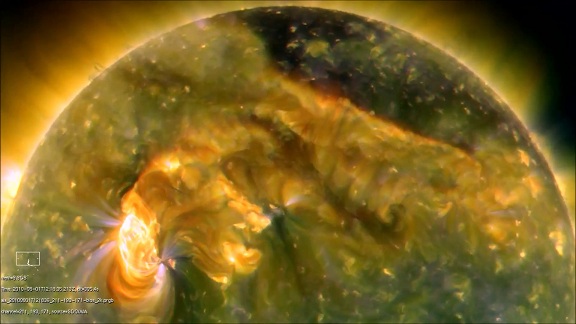| Online: | |
| Visits: | |
| Stories: |

| Story Views | |
| Now: | |
| Last Hour: | |
| Last 24 Hours: | |
| Total: | |
Global Eruption Rocks the Sun
On August 1, 2010, An entire hemisphere of the sun erupted. Filaments of magnetism snapped and exploded, shock waves raced across the stellar surface, billion-ton clouds of hot gas billowed into space. Astronomers knew they had witnessed something big.
It was so big, it may have shattered old ideas about solar activity.
“The August 1st event really opened our eyes,” says Karel Schrijver of Lockheed Martin’s Solar and Astrophysics Lab in Palo Alto, CA. “We see that solar storms can be global events, playing out on scales we scarcely imagined before.” http://science.nasa.gov/science-news/science-at-nasa/2010/13dec_globaleruption/
Watch the video here: https://www.youtube.com/watch?v=olT1HhKXt24

Image credit: NASA
DOUBLE FLARE: Long ago researchers thought solar flares were isolated events. Magnetic fields above a single sunspot became unstable and exploded–end of story.
The Solar Dynamics Observatory’s global view of the sun has shown, however, that widely-separated sunspots can explode in tandem. That’s what happened on March 20th when AR2010 and AR2014 combined for a double flare:
Transparent arcs of magnetism stretching across the 400,000 km divide between the two sunspots allow them to communicate magnetohydrodynamically, so instabilities in one can affect the other.
Read more: http://spaceweather.com/



